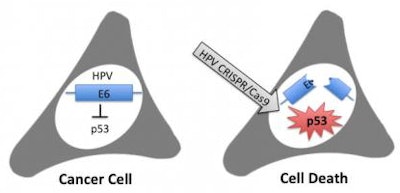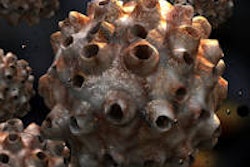
Researchers have hijacked a defense system normally used by bacteria to fend off viral infections and redirected it against human papillomavirus (HPV), the virus that causes cervical, head and neck, and other cancers, according to a new study in the Journal of Virology (August, 6, 2014).
Using a genome editing tool, researchers from Duke University were able to selectively destroy two viral genes responsible for the growth and survival of cervical carcinoma cells, causing the cancer cells to self-destruct.
The study findings validate an approach only recently attempted in mammalian cells, and they could help in the development of antiviral strategies against other DNA-based viruses such as hepatitis B and herpes simplex.
“This method has the potential to be a single-hit treatment that will dramatically reduce tumor load without having any effect on normal cells.”
"Because this approach is only going after viral genes, there should be no off-target effects on normal cells," said senior study author Bryan R. Cullen, PhD, a professor of molecular genetics and microbiology at the Duke University School of Medicine, in a statement. "You can think of this as targeting a missile that will destroy a certain target. You put in a code that tells the missile exactly what to hit, and it will only hit that, and it won't hit anything else because it doesn't have the code for another target."
When examining the genomes of different types of bacteria, researchers noted long stretches where the same genetic sequence was repeated. But in between these repeated stretches were DNA sequences that varied from bacteria to bacteria. About a decade ago, researchers determined that these varied sequences, clustered regularly interspaced short palindromic repeats (CRISPR), were derived from viruses that had infected the bacteria.
When bacteria are infected, a small portion of the offending viral DNA is copied and placed between the repeat elements for future reference. When the bacteria come into contact with that virus again, it has a "memory" of it, which activates the bacterial protein Cas9, which destroys any recognized offenders before they can hurt the bacteria again.
The CRISPR system is now being repurposed by researchers for many purposes, including introducing mutations for study or to repair genetic defects.
In the current study, Cullen decided to target HPV. Specifically, he and his colleagues went after two oncogenes that block the host's efforts to keep cancer cells at bay, viral genes E6 and E7.
To accomplish this, the researchers needed the target code for E6 or E7, consisting of a short strip of RNA sequence, and the Cas9 protein, which would cut any DNA that could line up and bind to that RNA sequence.
They packed the antiviral concoction into a viral vector based on a disabled version of HIV and infected cervical carcinoma cells in a lab dish with this genetically engineered virus. Researchers then assessed whether it could effectively destroy HPV infection and block cancer cell growth.
The carcinoma cells that received the anti-HPV guide RNA/Cas9 combination immediately stopped growing. In contrast, cells that had received a control virus, containing a random guide RNA sequence, continued to grow.
The researchers then looked at the consequences of destroying E6 or E7 in cancer cells. E6 normally blocks protein p53, which activates the so-called "suicide" pathways in a cell when it senses that something has gone wrong. In this study, targeting E6 enabled p53 to resume its normal function, causing the death of the cancer cell.
 Using a gene editing method known as CRISPR, Duke researchers were able to selectively destroy two viral genes responsible for the growth and survival of cervical carcinoma cells, causing the cancer cells to self-destruct. Image courtesy of Bryan Cullen, PhD.
Using a gene editing method known as CRISPR, Duke researchers were able to selectively destroy two viral genes responsible for the growth and survival of cervical carcinoma cells, causing the cancer cells to self-destruct. Image courtesy of Bryan Cullen, PhD.E7 works in a similar way, blocking a protein called retinoblastoma (Rb) that can trigger growth arrest and senescence, another form of cell death. As expected, the researchers found that targeting E7 also set this second tumor suppressor back in motion.
"As soon as you turn off E6 or E7, the host defense mechanisms are allowed to come back on again, because they have been there this whole time, but they have been turned off by HPV," Cullen said. "What happens is the cell immediately commits suicide."
Cullen and his colleagues are now working on developing a viral vector based on the adeno-associated virus, to deliver their CRISPR load into cancer cells. Tests in animal models will follow once that is in place.
"What we would hope to see in an HPV-induced cancer is rapid induction of tumor necrosis caused by loss of E6 or E7," Cullen said. "This method has the potential to be a single-hit treatment that will dramatically reduce tumor load without having any effect on normal cells."
The researchers are also targeting other viruses that use DNA as their genetic material, including the hepatitis B virus and herpes simplex virus.
The research was supported in part by funds from the National Institutes of Health.



















